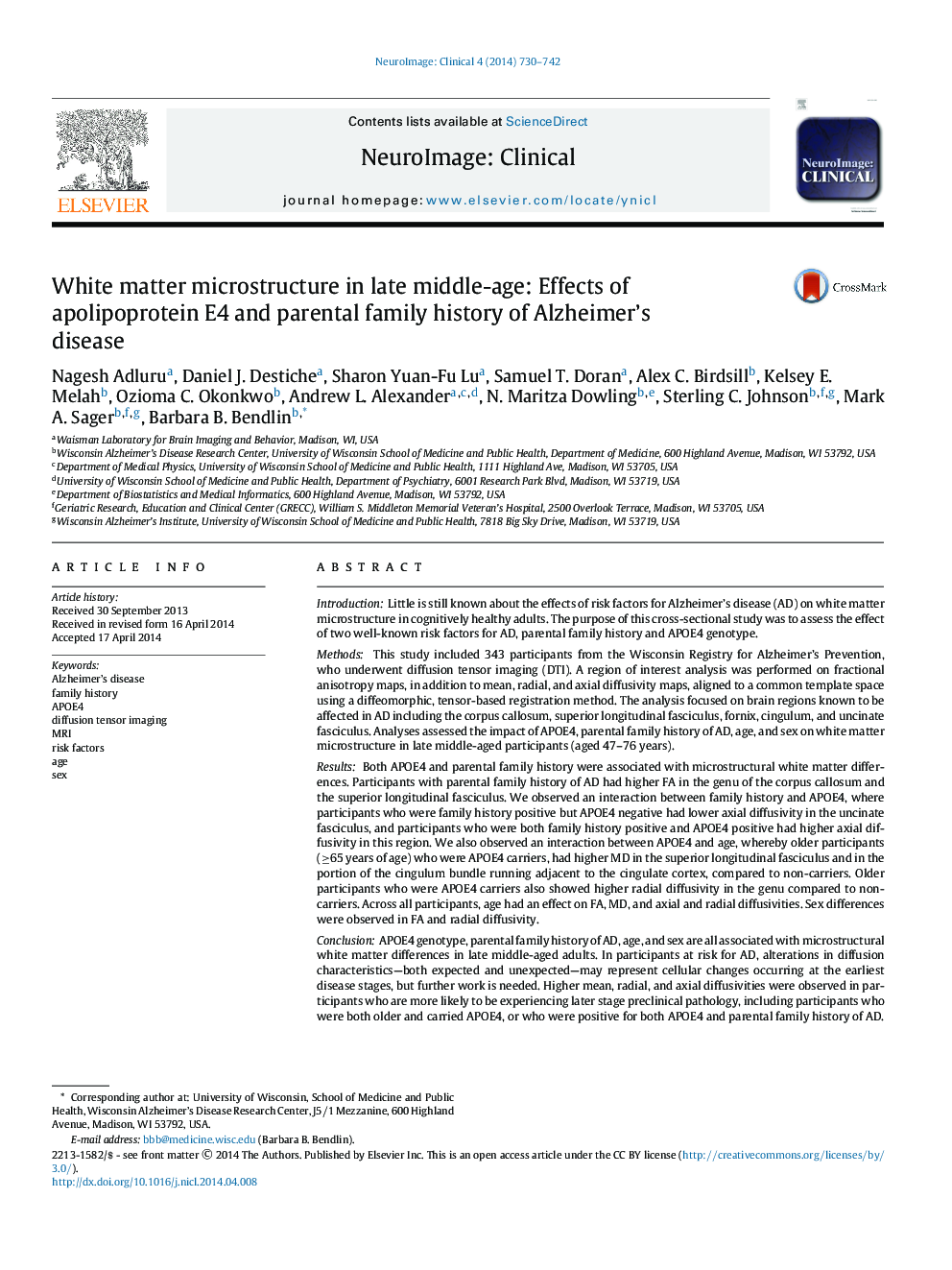| کد مقاله | کد نشریه | سال انتشار | مقاله انگلیسی | نسخه تمام متن |
|---|---|---|---|---|
| 3075357 | 1580963 | 2014 | 13 صفحه PDF | دانلود رایگان |

• Focused on participants (N = 343) in the Wisconsin Registry for Alzheimer's Prevention
• Examined effects of Alzheimer's disease risk on brain white matter utilizing DTI
• Parental family history was unexpectedly associated with higher fractional anisotropy.
• Lower diffusivities in certain risk groups may indicate early disease pathology.
• Results have implications for understanding preclinical disease pathology.
IntroductionLittle is still known about the effects of risk factors for Alzheimer's disease (AD) on white matter microstructure in cognitively healthy adults. The purpose of this cross-sectional study was to assess the effect of two well-known risk factors for AD, parental family history and APOE4 genotype.MethodsThis study included 343 participants from the Wisconsin Registry for Alzheimer's Prevention, who underwent diffusion tensor imaging (DTI). A region of interest analysis was performed on fractional anisotropy maps, in addition to mean, radial, and axial diffusivity maps, aligned to a common template space using a diffeomorphic, tensor-based registration method. The analysis focused on brain regions known to be affected in AD including the corpus callosum, superior longitudinal fasciculus, fornix, cingulum, and uncinate fasciculus. Analyses assessed the impact of APOE4, parental family history of AD, age, and sex on white matter microstructure in late middle-aged participants (aged 47–76 years).ResultsBoth APOE4 and parental family history were associated with microstructural white matter differences. Participants with parental family history of AD had higher FA in the genu of the corpus callosum and the superior longitudinal fasciculus. We observed an interaction between family history and APOE4, where participants who were family history positive but APOE4 negative had lower axial diffusivity in the uncinate fasciculus, and participants who were both family history positive and APOE4 positive had higher axial diffusivity in this region. We also observed an interaction between APOE4 and age, whereby older participants (≥65 years of age) who were APOE4 carriers, had higher MD in the superior longitudinal fasciculus and in the portion of the cingulum bundle running adjacent to the cingulate cortex, compared to non-carriers. Older participants who were APOE4 carriers also showed higher radial diffusivity in the genu compared to non-carriers. Across all participants, age had an effect on FA, MD, and axial and radial diffusivities. Sex differences were observed in FA and radial diffusivity.ConclusionAPOE4 genotype, parental family history of AD, age, and sex are all associated with microstructural white matter differences in late middle-aged adults. In participants at risk for AD, alterations in diffusion characteristics—both expected and unexpected—may represent cellular changes occurring at the earliest disease stages, but further work is needed. Higher mean, radial, and axial diffusivities were observed in participants who are more likely to be experiencing later stage preclinical pathology, including participants who were both older and carried APOE4, or who were positive for both APOE4 and parental family history of AD.
Journal: NeuroImage: Clinical - Volume 4, 2014, Pages 730–742